Whitman College
 | |
| Motto | per ardua surgo (Latin) |
|---|---|
Motto in English | Through adversities I rise |
| Type | Private liberal arts college |
| Established | December 20, 1859 |
Religious affiliation | Non-sectarian |
| Endowment | $514.7 million (2015)[1] |
| President | Kathleen M. Murray |
Academic staff | 200 |
| Undergraduates | 1,470[2] |
| Location |
Walla Walla, Washington, United States 46°04′14″N 118°19′44″W / 46.0706922°N 118.3288535°W |
| Campus | 117 acres (0.47 km2) |
| Colors | Navy Blue and Maize |
| Athletics | NCAA Division III – NWC |
| Sports | 15 varsity teams |
| Nickname | Blues |
| Affiliations |
Annapolis Group Oberlin Group CLAC Colleges That Change Lives |
| Website |
www |
|
| |



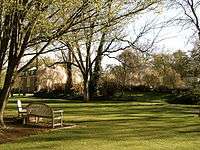
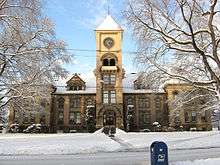
Whitman College is a private liberal arts college located in Walla Walla, Washington. Initially founded as a seminary by a territorial legislative charter in 1859, the school became a four-year degree-granting institution in 1883.[3] Whitman College is accredited by the Northwest Association of Schools and Colleges and competes athletically in the NCAA Division III Northwest Conference.[4] The school offers 46 majors and 32 minors in the liberal arts and sciences,[5] and has a student to faculty ratio of 9:1.[4] Whitman was the first college in the Pacific Northwest to install a Phi Beta Kappa chapter, and the first school in the United States to require comprehensive exams for graduation.[3] Whitman was ranked tied for 41st in the nation in the 2017 U.S. News & World Report list of Best Liberal Arts Colleges.[6] Whitman's acceptance rate for 2015 was 41%.[7]
History
Whitman Seminary
In 1859, soon after the United States military declared that the land east of the Cascade Mountains was open for settlement by American pioneers, Cushing Eells traveled from the Willamette Valley to Waiilatpu, near present-day Walla Walla, where 12 years earlier, Christian missionaries Dr. Marcus Whitman and Narcissa Whitman, along with 12 others were killed by a group of Cayuse Indians during the Whitman Massacre. While at the site, Eells became determined to establish a "monument" to his former missionary colleagues in the form of a school for pioneer boys and girls. Eells obtained a charter for Whitman Seminary, a pre-collegiate school, from the territorial legislature. From the American Board of Commissioners for Foreign Missions, he acquired the Whitman mission site. Eells soon moved to the site with his family and began working to establish Whitman Seminary.
Despite Eells's desire to locate Whitman Seminary at the Whitman mission site, local pressure and resources provided a way for the school to open in the burgeoning town of Walla Walla. In 1866, Walla Walla's wealthiest citizen, Dorsey Baker, donated land near his house to the east of downtown. A two-story wood-frame building was quickly erected and classes began later that year. The school's first principal, local Congregational minister Peasly B. Chamberlin, resigned within a year and Cushing Eells was called upon to serve as principal, which he did until 1869. After Eells's resignation in 1869, the school struggled—and often failed—to attract students, pay teachers, and stay open for each term.[8]
From seminary to college
Whitman's trustees decided in 1882 that while their institution could not continue as a prep school, it might survive as the area's only college. Alexander Jay Anderson, the former president of the Territorial University (now the University of Washington), came to turn the institution into a college and become its president. After modeling the institution after New England liberal arts colleges, Anderson opened the school on September 4, 1882 (Marcus Whitman's birthday) with an enrollment of 60 students and three senior faculty (Anderson, his wife and son). In 1883, the school received a collegiate charter and began expanding with aid from the Congregational American College and Education Society.[8]
Financial turmoil and new leadership
Despite local support for Whitman College and help from the Congregational community, financial troubles set in for the school. After losing favor with some of the school's supporters, Anderson left Whitman in 1891 to be replaced by Reverend James Francis Eaton. The continuing recession of the 1890s increased the institution's financial worries and lost Eaton his backing, leading to his resignation in 1894.[8]
Reverend Stephen Penrose, an area Congregational minister and former trustee, became president of the college and brought the school back to solvency by establishing Whitman's endowment with the aid of D. K. Pearsons, a Chicago philanthropist. By popularizing Marcus Whitman's life and accomplishments (including the suspect claim that the missionary had been pivotal in the annexation by the United States of Oregon Territory), Penrose was able to gain support and resources for the college. Under his leadership, the faculty was strengthened and the first masonry buildings, Billings Hall and the Whitman Memorial Building, were constructed.[8]
End of religious affiliation
In 1907, Penrose began a plan called "Greater Whitman" which sought to transform the college into an advanced technical and science center. To aid fundraising, Penrose abandoned affiliation with the Congregational Church, and became unaffiliated with any denomination. The prep school was closed and fraternities and sororities were introduced to the campus. Ultimately, this program was unable to raise enough capital; in 1912, the plan was abandoned and Whitman College returned to being a small liberal arts institution, albeit with increased focus on co-curricular activities.[8] Penrose iterated the school's purpose "to be a small college, with a limited number of students to whom it will give the finest quality of education".[9] In 1920 Phi Beta Kappa installed a chapter,[8] the first for a Northwest college,[10] and Whitman had its first alum Rhodes Scholar.[8]
World War II
During World War II, Whitman was one of 131 colleges and universities nationally that took part in the V-12 Navy College Training Program which offered students a path to a Navy commission.
Campus
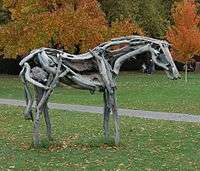
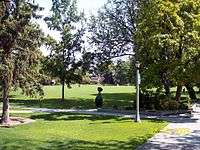
Whitman's 117 acre campus is located in downtown Walla Walla, Washington. Most of the campus is centered around a quad, which serves as the location for intramural field sports. Around this, Ankeny Field, sits Penrose Library, Olin Hall and Maxey Hall, and two residence halls, Lyman and Jewett. South of Ankeny Field, College Creek meanders through the main campus, filling the artificially created "Lakem Duckum", the heart of campus and the habitat for many of Whitman's beloved ducks.
The oldest building on campus is the administrative center, Whitman Memorial Building, commonly referred to as "Mem". Built in 1899, the hall, like the college, serves as a memorial to Dr. Marcus and Narcissa Prentiss Whitman. The building is the tallest on campus, and was placed on the National Historical Register of Historic Places in 1974. The oldest residence halls on campus, Lyman House and Prentiss Hall, were built in 1924 and 1926. Over the next fifty years, the college built or purchased several other buildings to house students, including the former Walla Walla Valley General Hospital, which was transformed into North Hall in 1978. In addition to the nine Residence Halls, many students choose to live in the eleven "Interest Houses," run for sophomores, juniors, and seniors committed to specific focuses such as community service, fine arts, environmental studies, multicultural awareness, or the French, Spanish, or German languages. These houses, like most of the residential architecture of the Walla Walla are in the Victorian or Craftsman style.
In addition to property in Walla Walla, the college also has about 22,000 acres (89 km2) of other land holdings – mainly in the form of wheat farms in Eastern Washington and Oregon. Of special note: the Johnston Wilderness Campus, which is used for academic and social retreats.
Academics
Whitman College focuses solely on undergraduate studies in the liberal arts. All students must take a two-semester course their first year, Encounters, which examines cultural interactions throughout history and gives students a grounding in the liberal arts. Students choose from courses in 46 major fields and 32 minor fields [11] and have wide flexibility in designing independent study programs, electing special majors, and participating in internships and study-abroad programs. Whitman's most popular majors are Biology, Psychology and Economics.[12] In addition, Whitman is noted for a strong science program.
Degrees are awarded after successful completion of senior "comprehensive exams." These exams vary depending on the students' primary focus of study, but commonly include some combination of (i) a senior thesis, (ii) written examination, and (iii) oral examination. The oral examination is either a defense of the student's senior thesis, or is one or multiple exams of material the student is expected to have learned during their major. The written exam is either a GRE subject test or a test composed by the department.
| University rankings | |
|---|---|
| National | |
| Forbes[13] | 53 |
| Liberal arts colleges | |
| U.S. News & World Report[14] | 41 |
| Washington Monthly[15] | 94 |
For students who are interested in foreign policy, Whitman is one of 16 institutions participating in the two-year-old Thomas R. Pickering Foreign Affairs Fellowship program.[16][17] The State Department pays for fellows to obtain their master's degree at the university of their choice in return for three years of service as a Foreign Service Officer. Whitman has a number of alumni who serve in diplomatic corps.
Combined programs
Whitman also offers combined programs in conjunction with several institutions throughout the United States:[18]
- 3–2 programs in engineering with the California Institute of Technology, Columbia University, Duke University, University of Washington, and Washington University;
- 3–2 programs in forestry and environmental management with Duke University, leading to a Master of Environmental Management or an MBA degree;
- A 3–2 program in oceanography at University of Washington, leading to a Whitman B.A. and a U. of Washington B.S. in Oceanography;
- A 4–1 combined program in elementary education with the Bank Street College of Education in New York City, culminating in a bachelor's degree from Whitman, a master's degree from Bank Street, and the requirements for teaching certification
Off-campus programs
Whitman offers a "Semester in the West" program, a field study program in environmental studies, focusing on ecological, social, and political issues confronting the American West. During every other fall semester since 2002, 21 students leave Walla Walla to travel throughout interior West for field meetings with a variety of leading figures in conservation, ecology, environmental writing, and social justice.[19]
Whitman also offers "The U.S.-Mexico Border Program" every other June. The program is based in Arizona and Sonora, Mexico, and exposes students to a wide range of competing perspectives on the politics of immigration, border enforcement, and globalization.[20]
Since 1982, "Whitman in China" provides Whitman Alumni the opportunity to teach English at a Northwestern Polytechnical University, Shantou University, or the Yunnan University. Participants receive an immersion experience in urban Chinese culture, where they can witness the rapid modernization of the country. At the same time, Whitman alumni give Chinese university students the rare chance to study with an English native speaker.[21]
Whitman also offers a large range of year- or semester-long off-campus study programs - 88 programs across 40 countries,[22] and a few short-term, faculty-led programs.[23]
Admissions
Admission to Whitman is considered "most selective" according to U.S. News & World Report.[6] There were 3,933 applications for admission to the Class of 2019: 1,664 were admitted (42.0%) and 381 enrolled.[24] The enrolling freshmen class' middle 50% range of SAT scores was 600–720 for reading, 610–700 for math, and 600–700 for writing, while the ACT Composite range was 28–32.[24]
Student life
Of the 1,539 undergraduate students enrolled in Whitman College in the fall of 2014, 56.3% were female and 43.7% male.[2] There are over one hundred student activities, many of which focus on student activism and social improvement, such as Whitman Direct Action and Global Medicine. A quarter of the student body participates in some for the college's music program, in one of the 15 music groups and ensembles, including three recognized A cappella groups.
Greek life is notable on campus; there is a high percentage of students, around 33% involved in the Greek system. The four women's sororities, (Kappa Alpha Theta, Delta Gamma, Alpha Phi, and Kappa Kappa Gamma) are housed in the Prentiss Hall, while the four men's fraternities, (Sigma Chi, Beta Theta Pi, Phi Delta Theta, and Tau Kappa Epsilon) are housed in fraternity houses north of Isaacs Avenue.
The Delta chapter of Phrateres, a non-exclusive, non-profit social-service club, also had a brief existence at Whitman. It was installed there in 1930, but became inactive before 1950.
Athletics
Whitman holds membership in the NCAA's Northwest Conference (Division III) and fields nine varsity teams each for men and women. In 2016 the college adopted the new mascot for the school and its athletes of "the blues," named after the local mountain range. More than 20 percent of students participate in a varsity sport. In addition, 70 percent of the student body participate in intramural and club sport. These sports include rugby union, waterpolo, lacrosse, dodgeball, and nationally renowned cycling and Ultimate teams.
In addition, the Whitman Cycling team has won DII National Championships for the past 2 years, and 4 times in the past 6 years, making them the athletic team at Whitman with the most National Championships, despite their club sport status.
And, the Women's Ultimate team, also a club sports team, finished second to Stanford in Division I play in 2016.[25]
KWCW 90.5 FM
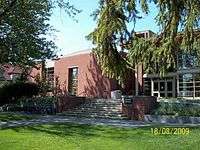
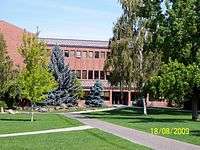
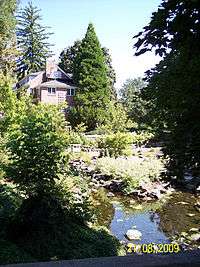
KWCW 90.5 FM is a Class A radio station owned and operated by the Whitman Students' Union, the Associated Students of Whitman College (ASWC).
"K-dub" as it is known to students, is located inside the Reid Campus Center on Whitman Campus. Broadcasting at a power of 160 watts, the station's range is approximately 15 miles (24 km) as well as online at kwcwradio.tumblr.com.
College leadership
Whitman College is governed by Trustees in conjunction with a college President, Overseers and Alumni Board.
List of presidents
- Alexander J. Anderson, 1882–1891
- James F. Eaton, 1891–1894
- Stephen B. L. Penrose, 1894–1934
- Rudolf A. Clemen, 1934–1936
- Walter Andrew Bratton, 1936–1942
- Winslow S. Anderson, 1942–1948
- Chester C. Maxey, 1948–1959
- Louis B. Perry, 1959–1967
- Donald Sheehan, 1968–1974
- Robert Allen Skotheim, 1975–1988
- David Evans Maxwell, 1989–1993
- Thomas E. Cronin, 1993–2005
- George Sumner Bridges, 2005–June 2015
- Kathleen M. Murray, July 2015 – present
Alumni board
Whitman College alumni started the Alumni Association in 1895 to relay alumni reaction to college programs back to the Alumni Office. The current president of the board is Kirsten Adams Gable '01, and Mary Deming Barber '78, is vice president.[26]
Notable alumni
Government
- 1920 – William O. Douglas, BA English-Economics, U.S. Supreme Court Justice.
- 1935 – Al Ullman, U.S. congressman for 24 years.
- 1941 – Lucile Lomen, first woman to serve as a law clerk for a Supreme Court justice.
- 1955 – Al Swift, attended two years, Washington Congressman.
- 1960 – Pat Thibaudeau, BA Psychology, former Washington State Senator.
- 1963 – W. Michael Gillette, BA, Oregon Supreme Court Justice.
- 1964 – Walt Minnick, BA, former Idaho Congressman.
- 1969 - James L. Robart, United States Federal Judge
- 1971 – Ryan Crocker, BA English, former U.S. Ambassador to Afghanistan and former U.S. Ambassador to Iraq, Lebanon, Kuwait, Syria, and Pakistan.
- 1971– Ben Westlund, BA Education/History, former Oregon State Treasurer.
- 2000 - Neil Kornze, BA Politics, current director of the U.S. Bureau of Land Management.
Arts and entertainment
- 1951 – Adam West, BA English, actor, Batman, Family Guy.
- 1967 – Dirk Benedict (Niewoehner), BA Dramatic Art, actor, known for Battlestar Galactica and The A-Team.
- 1967 - Craig Lesley, novelist
- 1971– Jack Rasmussen, BA Art, Director and Curator of the American University Museum.
- 1971– Kathryn Shaw, BA Dramatic Art, artistic director of Studio 58 in Vancouver, British Columbia.
- 1977 – Rick Stevenson, BA History, film writer, director and producer.
- 1985 – Lance Norris, BA Dramatic Art, Mystic River.
- 1985 - Patrick Page, actor and playwright
- 1998 - Shane Johnson, actor, "Saving Private Ryan", Black Cadillac"
- 2002 – Anomie Belle, BA Sociology, professional musician.
- 2003 - Cullen Hoback, filmmaker, "Terms and Conditions May Apply"
- 2005 - Drew Shoals, drummer for Train, band
- 2012 - Gretchen Grimm, Lydia Lund, Julia Shapiro, Annie Truscott, recording artists, Chastity Belt (band)
- Morten Lauridsen (attended two years), composer, recipient National Medal of Arts; Distinguished Professor of Composition, USC Thornton School of Music
- Otto Harbach, MA, lyricist and librettist of about 50 musical comedies, including Rose Marie and The Desert Song.
Journalism and history
- 1933 – Gordon Wright, BA, historian.
- 1959 – Diane Middlebrook, attended, biographer of Anne Sexton.
- 1960 – Douglas Cole, BA Art History, historian specializing in art and Pacific Northwest cultural history.
- 1971– John Markoff, BA Sociology, New York Times journalist and co-author of Takedown.
Academia
- 1919 – Frances Penrose Owen, BA Greek, honored for her extensive public service in Seattle, first woman Regent of Washington State University
- 1924 – Vladimir Rojansky, physicist, author and educator.
- 1944 – Dan Fenno Henderson, founder of the University of Washington Asian law program[27]
- 1965 – Ben Kerkvliet, author and educator in the fields of comparative politics, Southeast Asia and Asian studies.
- 1970 – Stephen A. Hayner, BA English Literature, president of Columbia Theological Seminary, former president of InterVarsity Christian Fellowship.
- 1973 – Torey Hayden, BA, Biology/Chemistry, child psychologist, special education teacher, university lecturer and author.
- 1982 – Keely Stauter-Halsted, BA History, Hejna Chair in the History of Poland at the University of Illinois at Chicago
- 1992 – Annee Hartzell, BA Politics, Teacher of the blind, 2009 National Federation of the Blind's teacher of the year.
Business
- 1922 – Ralph Cordiner,[28] BA Economics-Political Science, CEO and chairman, General Electric, Corp.(1958–1963); President (1950–1958)
- 1977 – John W. Stanton, BA Political Science, Founder and CEO, Western Wireless.
- 2005 - Ashifi Gogo, BA, Mathematics and Physics, Co-founder Sproxil.
Science and technology
- 1908 – David Crockett Graham, BA, missionary, archeologist, anthropologist, field collector for Smithsonian.
- 1918 - Edith Quimby, BA mathematics and physics, medical researcher and physicist
- 1921 – Wallace R. Brode, BA, chemist, absorption spectra of dyes.
- 1924 – Walter Brattain, BA Physics, physicist, co-inventor of the transistor, Nobel Prize winner.
- 1934 – Bernard Berelson, BA English, behavioral scientist known for work on communication and mass media.
- 1960 – David R. Nygren, particle physicist, inventor of the Time projection chamber.
- 1965 – Webb Miller, BA, Computational Biology Pioneer. Time 100, 2009: Scientists and Thinkers
- 1993 - Rick Turoczy, BA English, cofounder of the Portland Incubator Experiment
- 1997 – Dorothy Metcalf-Lindenburger, BA Geology, NASA astronaut.
Athletics
- 1998 - Tommy Lloyd, Assistant Basketball Coach, Gonzaga University
- 2000 – Ingrid Backstrom, BA Geology, professional skier.
- 2004 – Holly Brooks, BA Sociology, Environmental Studies, Winter Olympian in Nordic skiing.
- 2008 - Mara Abbott, BA Economics, professional cyclist.
Other
- 1974 – Marlin Eller, BA Mathematics, programmer and software developer, co-author of Barbarians Led by Bill Gates
- 1985 – Steve McConnell, software engineering author, Code Complete
- Jack Fearey, attended three years, television pioneer at KING-TV, director of the Seattle Center, established the Bumbershoot and the Northwest Folklife Festival.
Alma mater
Whitman's Alma mater is rarely heard today outside of Commencement, other than being sung regularly by the Whitman College Chorale. Dating from 1914, the "The Whitman Hymn" was written and composed by President Penrose to create school unity and spirit.
- When the morning light is breaking,
- O're the mountain's eastern rim
- And the world to work is waking
- Let us sing our happy hymn.
- Here's to the blue sky above us,
- Here's to the wheat field's gold,
- Here's to the friends that love us,
- And our love will ne're grow cold.
- For friends and fields and mountains
- Under heaven's kindly blue.
- And the college 'mid the fountains,
- dear old Whitman here's to you
- With the joys of life before us,
- and life's battle stern and grim
- With the kindly heaven o're us,
- We will sing our happy hymn.
References
- ↑ As of June 30, 2015. "U.S. and Canadian Institutions Listed by Fiscal Year (FY) 2015 Endowment Market Value and Change in Endowment Market Value from FY 2014 to FY 2015" (PDF). National Association of College and University Business Officers and Commonfund Institute. 2016.
- 1 2 "Whitman Factbook". Office of Institutional Research, Whitman College.
- 1 2 https://www.whitman.edu/about/whitman-hallmarks/history-of-the-college History of Whitman College, Retrieved July 28, 2010.
- 1 2 https://www.whitman.edu/about/fast-facts Fast Facts About Whitman College, Retrieved September 20, 2015.
- ↑ Majors and Minors at Whitman College Retrieved September 29, 2016.
- 1 2 "National Liberal Arts Colleges Rankings". U.S. News & World Report. 2017.
- ↑ "Admitted Class Profile". Whitman College. 2015.
- 1 2 3 4 5 6 7 http://www.historylink.org/index.cfm?DisplayPage=output.cfm&File_Id=8337 History Link: Whitman College, Retrieved July 28, 2010.
- ↑ Edwards, Thomas G. The Triumph of Tradition: The Emergence of Whitman College, 1859–1924 Whitman College 1993 p 424
- ↑ History of Whitman College Retrieved July 28, 2010.
- ↑ "Whitman College Catalog". Whitman College. Retrieved 29 Sep 2016.
- ↑ (PDF) https://www.whitman.edu/Documents/Offices/Institutional%20Research/The%20Factbook%202015%20as%20of%2012.2.15(0).pdf. Retrieved 29 Sep 2016. Missing or empty
|title=(help) - ↑ "America's Top Colleges". Forbes. July 5, 2016.
- ↑ "Best Colleges 2017: National Liberal Arts Colleges Rankings". U.S. News & World Report. September 12, 2016.
- ↑ "2016 Rankings - National Universities - Liberal Arts". Washington Monthly. Retrieved September 6, 2016.
- ↑ Woodrow Wilson National Fellowship Foundation: Undergraduate Foreign Affairs
- ↑ Archived April 12, 2007, at the Wayback Machine.
- ↑ Whitman Departments and Programs
- ↑ "Semester in the West Program".
- ↑ "U.S.-Mexico Border Program".
- ↑ "Whitman in China Program".
- ↑ "Fast Facts".
- ↑ "Faculty-led off-campus courses".
- 1 2 "Admitted Class Profile". Office of Institutional Research, Whitman College.
- ↑ "Stanford 1st, Whitman 2nd in 2016 Women's Ultimate Division I Championships". USA Ultimate. Retrieved 10 June 2016.
- ↑ "Alumni Board and Alumni Association". Whitman College. Retrieved September 20, 2015.
- ↑ Sanders, Eli. "Dan Henderson, UW program founder, dies." Seattle Times. March 18, 2001. Retrieved on May 5, 2012.
- ↑ "Biography: Ralph J. Cordiner". GE Past leaders, GE website
Further reading
- Eells, Myron (1888). The hand of God in the history of the Pacific Coast : annual address delivered before the trustees, faculty, students and friends of Whitman College at the sixth commencement, June 1, 1888.
External links
| Wikimedia Commons has media related to Whitman College. |
- Official website
- Official athletics website
-
 "Whitman College". Collier's New Encyclopedia. 1921.
"Whitman College". Collier's New Encyclopedia. 1921. -
 "Whitman College". Encyclopedia Americana. 1920.
"Whitman College". Encyclopedia Americana. 1920.